A Systematic Review of the Research Development on the Application of Machine Learning for Concrete
Abstract
:1. Introduction
1.1. Background
1.2. Literature Review
1.3. Categories of Machine Learning
1.4. Motivation and Significance of the the Study
2. Review Strategy
3. Results Analysis
3.1. Subject Areas and Annual Articles Published
3.2. Publication Sources
3.3. Keywords
3.4. Authors
3.5. Documents
3.6. Countries
4. Discussions and Recommendations for Future Work
5. Conclusions
- An assessment of publication journals including articles on ML for concrete research revealed that “CONBUILDMAT”, “Materials”, and “Engineering Structures” were the top three sources, with 94, 52, and 48 publications, respectively. In terms of total citations, the top three publishing sources were “CONBULDMAT” with 1677, “Engineering Structures” with 602, and “Materials” with 441.
- A keyword analysis of the topic research field revealed that machine learning, learning systems, forecasting, concretes, and compressive strength were the five terms occurring most often. The keyword analysis found that machine learning had mostly been used to forecast concrete properties, particularly compressive strength.
- The author analysis found that just 53 authors had published at least 7 articles on ML for concrete research. The leading authors were categorized according to their document count, overall citations, and average citations. With 25 publications, Aslam F. was the most prolific author, followed by Wang Y. with 22 and Nehdi M.L. with 19 papers. In terms of total citations, Mangalathu S. had the highest number, with 385, followed by Wang Y. with 351 and Nehdi M.L. with 327 total citations. Moreover, when comparing the average number of citations, the following writers stood out: Mangalathu S. with roughly 48 citations, Alyousef R. with nearly 24, and Liu J., Li S., and Feng D.-C., each with an average number of citations of about 48.
- An evaluation of articles offering data on ML applications for concrete revealed that the study by Prasanna P. [98] on “Automated Crack Detection on Concrete Bridges” received 224 citations. Rafiei M.H. [99] and Chou J.-S. [100] obtained 184 and 174 citations, respectively, for their studies and were among the top three. In addition, as of May 2022, only 14 papers had received more than 100 citations in the topic field.
- Based on their engagement in ML concrete research, the main countries were identified, and it was found that only 31 countries had produced at least 10 publications. The United States, China, and India produced 298, 289, and 110 papers, respectively. In addition, the papers from the United States received 4260 citations, those from China received 2732 citations, and those from Vietnam received 1633 citations.
- These revolutionary techniques will aid the building sector by enabling the creation of efficient and economical methods for evaluating the properties of materials. In addition, the adoption and application of a material in the building sector will be expedited by encouraging computational methods.
- The prevalence of ML applications is forecast to increase as the Internet of Things, big data, and automated systems continue to dominate the industrial sector in the next decades.
- To improve the performance of ML models, it is recommended that a greater number of input factors should be employed, such as the chemical composition of raw components and the environmental conditions (humidity and temperature). In addition, increasing the number of data samples through additional experimental testing may improve the performance of ML models in terms of real and precise predictions.
Author Contributions
Funding
Institutional Review Board Statement
Informed Consent Statement
Data Availability Statement
Acknowledgments
Conflicts of Interest
References
- Khambra, G.; Shukla, P. Novel machine learning applications on fly ash based concrete: An overview. Mater. Today Proc. 2021; in press. [Google Scholar] [CrossRef]
- Popov, V.V.; Kudryavtseva, E.V.; Kumar Katiyar, N.; Shishkin, A.; Stepanov, S.I.; Goel, S. Industry 4.0 and Digitalisation in Healthcare. Materials 2022, 15, 2140. [Google Scholar] [CrossRef] [PubMed]
- Kaya Keleş, M. An overview: The impact of data mining applications on various sectors. Teh. Glas. 2017, 11, 128–132. [Google Scholar]
- Kim, K.; Kim, W.; Seo, J.; Jeong, Y.; Lee, M.; Lee, J. Prediction of Concrete Fragments Amount and Travel Distance under Impact Loading Using Deep Neural Network and Gradient Boosting Method. Materials 2022, 15, 1045. [Google Scholar] [CrossRef] [PubMed]
- Mesfin, W.M.; Cho, S.; Lee, J.; Kim, H.-K.; Kim, T. Deep-Learning-Based Segmentation of Fresh or Young Concrete Sections from Images of Construction Sites. Materials 2021, 14, 6311. [Google Scholar] [CrossRef]
- Chaabene, W.B.; Flah, M.; Nehdi, M.L. Machine learning prediction of mechanical properties of concrete: Critical review. Constr. Build. Mater. 2020, 260, 119889. [Google Scholar] [CrossRef]
- Deng, F.; He, Y.; Zhou, S.; Yu, Y.; Cheng, H.; Wu, X. Compressive strength prediction of recycled concrete based on deep learning. Constr. Build. Mater. 2018, 175, 562–569. [Google Scholar] [CrossRef]
- Ahmad, A.; Chaiyasarn, K.; Farooq, F.; Ahmad, W.; Suparp, S.; Aslam, F. Compressive Strength Prediction via Gene Expression Programming (GEP) and Artificial Neural Network (ANN) for Concrete Containing RCA. Buildings 2021, 11, 324. [Google Scholar] [CrossRef]
- Taherei Ghazvinei, P.; Hassanpour Darvishi, H.; Mosavi, A.; Yusof, K.b.W.; Alizamir, M.; Shamshirband, S.; Chau, K.-W. Sugarcane growth prediction based on meteorological parameters using extreme learning machine and artificial neural network. Eng. Appl. Comput. Fluid Mech. 2018, 12, 738–749. [Google Scholar] [CrossRef] [Green Version]
- Band, S.S.; Janizadeh, S.; Chandra Pal, S.; Saha, A.; Chakrabortty, R.; Shokri, M.; Mosavi, A. Novel Ensemble Approach of Deep Learning Neural Network (DLNN) Model and Particle Swarm Optimization (PSO) Algorithm for Prediction of Gully Erosion Susceptibility. Sensors 2020, 20, 5609. [Google Scholar] [CrossRef]
- Ziolkowski, P.; Niedostatkiewicz, M.; Kang, S.-B. Model-Based Adaptive Machine Learning Approach in Concrete Mix Design. Materials 2021, 14, 1661. [Google Scholar] [CrossRef] [PubMed]
- Shin, H.K.; Ahn, Y.H.; Lee, S.H.; Kim, H.Y. Automatic Concrete Damage Recognition Using Multi-Level Attention Convolutional Neural Network. Materials 2020, 13, 5549. [Google Scholar] [CrossRef] [PubMed]
- Wang, W.; Shi, P.; Deng, L.; Chu, H.; Kong, X. Residual Strength Evaluation of Corroded Textile-Reinforced Concrete by the Deep Learning-Based Method. Materials 2020, 13, 3226. [Google Scholar] [CrossRef]
- Emadi, M.; Taghizadeh-Mehrjardi, R.; Cherati, A.; Danesh, M.; Mosavi, A.; Scholten, T. Predicting and Mapping of Soil Organic Carbon Using Machine Learning Algorithms in Northern Iran. Remote Sens. 2020, 12, 2234. [Google Scholar] [CrossRef]
- Torabi, M.; Hashemi, S.; Saybani, M.R.; Shamshirband, S.; Mosavi, A. A Hybrid clustering and classification technique for forecasting short-term energy consumption. Environ. Prog. Sustain. Energy 2019, 38, 66–76. [Google Scholar] [CrossRef] [Green Version]
- Golafshani, E.M.; Behnood, A.; Arashpour, M. Predicting the compressive strength of normal and High-Performance Concretes using ANN and ANFIS hybridized with Grey Wolf Optimizer. Constr. Build. Mater. 2020, 232, 117266. [Google Scholar] [CrossRef]
- Nunez, I.; Marani, A.; Nehdi, M.L. Mixture Optimization of Recycled Aggregate Concrete Using Hybrid Machine Learning Model. Materials 2020, 13, 4331. [Google Scholar] [CrossRef]
- Amin, M.N.; Khan, K.; Javed, M.F.; Aslam, F.; Qadir, M.G.; Faraz, M.I. Prediction of Mechanical Properties of Fly-Ash/Slag-Based Geopolymer Concrete Using Ensemble and Non-Ensemble Machine-Learning Techniques. Materials 2022, 15, 3478. [Google Scholar] [CrossRef]
- Lei, X.; Chen, W.; Avand, M.; Janizadeh, S.; Kariminejad, N.; Shahabi, H.; Costache, R.; Shahabi, H.; Shirzadi, A.; Mosavi, A. GIS-Based Machine Learning Algorithms for Gully Erosion Susceptibility Mapping in a Semi-Arid Region of Iran. Remote Sens. 2020, 12, 2478. [Google Scholar] [CrossRef]
- Band, S.S.; Janizadeh, S.; Chandra Pal, S.; Saha, A.; Chakrabortty, R.; Melesse, A.M.; Mosavi, A. Flash Flood Susceptibility Modeling Using New Approaches of Hybrid and Ensemble Tree-Based Machine Learning Algorithms. Remote Sens. 2020, 12, 3568. [Google Scholar] [CrossRef]
- Jordan, M.I.; Mitchell, T.M. Machine learning: Trends, perspectives, and prospects. Science 2015, 349, 255–260. [Google Scholar] [CrossRef] [PubMed]
- Qasem, S.N.; Samadianfard, S.; Sadri Nahand, H.; Mosavi, A.; Shamshirband, S.; Chau, K.-W. Estimating Daily Dew Point Temperature Using Machine Learning Algorithms. Water 2019, 11, 582. [Google Scholar] [CrossRef] [Green Version]
- Mosavi, A.; Sajedi Hosseini, F.; Choubin, B.; Goodarzi, M.; Dineva, A.A.; Rafiei Sardooi, E. Ensemble boosting and bagging based machine learning models for groundwater potential prediction. Water Resour. Manag. 2021, 35, 23–37. [Google Scholar] [CrossRef]
- Libbrecht, M.W.; Noble, W.S. Machine learning applications in genetics and genomics. Nat. Rev. Genet. 2015, 16, 321–332. [Google Scholar] [CrossRef] [Green Version]
- Sadeghzadeh, M.; Maddah, H.; Ahmadi, M.H.; Khadang, A.; Ghazvini, M.; Mosavi, A.; Nabipour, N. Prediction of Thermo-Physical Properties of TiO2-Al2O3/Water Nanoparticles by Using Artificial Neural Network. Nanomaterials 2020, 10, 697. [Google Scholar] [CrossRef] [Green Version]
- Ramprasad, R.; Batra, R.; Pilania, G.; Mannodi-Kanakkithodi, A.; Kim, C. Machine learning in materials informatics: Recent applications and prospects. NPJ Comput. Mater. 2017, 3, 54. [Google Scholar] [CrossRef]
- Shabani, S.; Samadianfard, S.; Sattari, M.T.; Mosavi, A.; Shamshirband, S.; Kmet, T.; Várkonyi-Kóczy, A.R. Modeling Pan Evaporation Using Gaussian Process Regression K-Nearest Neighbors Random Forest and Support Vector Machines; Comparative Analysis. Atmosphere 2020, 11, 66. [Google Scholar] [CrossRef] [Green Version]
- Sun, L.; Koopialipoor, M.; Jahed Armaghani, D.; Tarinejad, R.; Tahir, M.M. Applying a meta-heuristic algorithm to predict and optimize compressive strength of concrete samples. Eng. Comput. 2021, 37, 1133–1145. [Google Scholar] [CrossRef]
- Khan, M.; Cao, M.; Xie, C.; Ali, M. Effectiveness of hybrid steel-basalt fiber reinforced concrete under compression. Case Stud. Constr. Mater. 2022, 16, e00941. [Google Scholar] [CrossRef]
- Khan, M.; Cao, M.; Chaopeng, X.; Ali, M. Experimental and analytical study of hybrid fiber reinforced concrete prepared with basalt fiber under high temperature. Fire Mater. 2022, 46, 205–226. [Google Scholar] [CrossRef]
- Khan, M.; Cao, M.; Ai, H.; Hussain, A. Basalt Fibers in Modified Whisker Reinforced Cementitious Composites. Period. Polytech. Civ. Eng. 2022, 66, 344–354. [Google Scholar] [CrossRef]
- Khan, M.; Cao, M.; Hussain, A.; Chu, S.H. Effect of silica-fume content on performance of CaCO3 whisker and basalt fiber at matrix interface in cement-based composites. Constr. Build. Mater. 2021, 300, 124046. [Google Scholar] [CrossRef]
- Khan, M.; Rehman, A.; Ali, M. Efficiency of silica-fume content in plain and natural fiber reinforced concrete for concrete road. Constr. Build. Mater. 2020, 244, 118382. [Google Scholar] [CrossRef]
- Khan, M.; Ali, M. Improvement in concrete behavior with fly ash, silica-fume and coconut fibres. Constr. Build. Mater. 2019, 203, 174–187. [Google Scholar] [CrossRef]
- Ahmad, W.; Ahmad, A.; Ostrowski, K.A.; Aslam, F.; Joyklad, P.; Zajdel, P. Application of Advanced Machine Learning Approaches to Predict the Compressive Strength of Concrete Containing Supplementary Cementitious Materials. Materials 2021, 14, 5762. [Google Scholar] [CrossRef]
- Thomas, B.S.; Yang, J.; Bahurudeen, A.; Abdalla, J.A.; Hawileh, R.A.; Hamada, H.M.; Nazar, S.; Jittin, V.; Ashish, D.K. Sugarcane bagasse ash as supplementary cementitious material in concrete—A review. Mater. Today Sustain. 2021, 15, 100086. [Google Scholar] [CrossRef]
- Ahmad, W.; Ahmad, A.; Ostrowski, K.A.; Aslam, F.; Joyklad, P. A scientometric review of waste material utilization in concrete for sustainable construction. Case Stud. Constr. Mater. 2021, 15, e00683. [Google Scholar] [CrossRef]
- Li, X.; Qin, D.; Hu, Y.; Ahmad, W.; Ahmad, A.; Aslam, F.; Joyklad, P. A systematic review of waste materials in cement-based composites for construction applications. J. Build. Eng. 2021, 45, 103447. [Google Scholar] [CrossRef]
- Yang, Z.; Liu, S.; Yu, L.; Xu, L. A Comprehensive Study on the Hardening Features and Performance of Self-Compacting Concrete with High-Volume Fly Ash and Slag. Materials 2021, 14, 4286. [Google Scholar] [CrossRef]
- Tomczak, K.; Jakubowski, J.; Kotwica, Ł. Key Factors Determining the Self-Healing Ability of Cement-Based Composites with Mineral Additives. Materials 2021, 14, 4211. [Google Scholar] [CrossRef]
- Nafees, A.; Amin, M.N.; Khan, K.; Nazir, K.; Ali, M.; Javed, M.F.; Aslam, F.; Musarat, M.A.; Vatin, N.I. Modeling of Mechanical Properties of Silica Fume-Based Green Concrete Using Machine Learning Techniques. Polymers 2022, 14, 30. [Google Scholar] [CrossRef] [PubMed]
- Alyousef, R.; Ahmad, W.; Ahmad, A.; Aslam, F.; Joyklad, P.; Alabduljabbar, H. Potential use of recycled plastic and rubber aggregate in cementitious materials for sustainable construction: A review. J. Clean. Prod. 2021, 329, 129736. [Google Scholar] [CrossRef]
- Li, G.; Zhou, C.; Ahmad, W.; Usanova, K.I.; Karelina, M.; Mohamed, A.M.; Khallaf, R. Fly Ash Application as Supplementary Cementitious Material: A Review. Materials 2022, 15, 2664. [Google Scholar] [CrossRef] [PubMed]
- Khan, M.; Ali, M. Effect of super plasticizer on the properties of medium strength concrete prepared with coconut fiber. Constr. Build. Mater. 2018, 182, 703–715. [Google Scholar] [CrossRef]
- Cao, M.; Khan, M. Effectiveness of multiscale hybrid fiber reinforced cementitious composites under single degree of freedom hydraulic shaking table. Struct. Concr. 2021, 22, 535–549. [Google Scholar] [CrossRef]
- Khan, M.; Cao, M.; Xie, C.; Ali, M. Efficiency of basalt fiber length and content on mechanical and microstructural properties of hybrid fiber concrete. Fatigue Fract. Eng. Mater. Struct. 2021, 44, 2135–2152. [Google Scholar] [CrossRef]
- Chang, Q.; Zhao, C.; Xing, L.; Ahmad, W.; Javed, M.F.; Aslam, F.; Musarat, M.A.; Vatin, N.I. Concrete filled double steel tube columns incorporating UPVC pipes under uniaxial compressive load at ambient and elevated temperature. Case Stud. Constr. Mater. 2022, 16, e00907. [Google Scholar] [CrossRef]
- Shen, Z.; Deifalla, A.F.; Kamiński, P.; Dyczko, A. Compressive Strength Evaluation of Ultra-High-Strength Concrete by Machine Learning. Materials 2022, 15, 3523. [Google Scholar] [CrossRef]
- Khan, K.; Ahmad, W.; Amin, M.N.; Aslam, F.; Ahmad, A.; Al-Faiad, M.A. Comparison of Prediction Models Based on Machine Learning for the Compressive Strength Estimation of Recycled Aggregate Concrete. Materials 2022, 15, 3430. [Google Scholar] [CrossRef]
- Ullah, H.S.; Khushnood, R.A.; Farooq, F.; Ahmad, J.; Vatin, N.I.; Ewais, D.Y. Prediction of Compressive Strength of Sustainable Foam Concrete Using Individual and Ensemble Machine Learning Approaches. Materials 2022, 15, 3166. [Google Scholar] [CrossRef]
- Xu, Y.; Ahmad, W.; Ahmad, A.; Ostrowski, K.A.; Dudek, M.; Aslam, F.; Joyklad, P. Computation of High-Performance Concrete Compressive Strength Using Standalone and Ensembled Machine Learning Techniques. Materials 2021, 14, 7034. [Google Scholar] [CrossRef] [PubMed]
- Yuan, X.; Tian, Y.; Ahmad, W.; Ahmad, A.; Usanova, K.I.; Mohamed, A.M.; Khallaf, R. Machine Learning Prediction Models to Evaluate the Strength of Recycled Aggregate Concrete. Materials 2022, 15, 2823. [Google Scholar] [CrossRef] [PubMed]
- Zhu, Y.; Ahmad, A.; Ahmad, W.; Vatin, N.I.; Mohamed, A.M.; Fathi, D. Predicting the Splitting Tensile Strength of Recycled Aggregate Concrete Using Individual and Ensemble Machine Learning Approaches. Crystals 2022, 12, 569. [Google Scholar] [CrossRef]
- Liu, T.; Nafees, A.; Javed, M.F.; Aslam, F.; Alabduljabbar, H.; Xiong, J.-J.; Khan, M.I.; Malik, M.Y. Comparative study of mechanical properties between irradiated and regular plastic waste as a replacement of cement and fine aggregate for manufacturing of green concrete. Ain Shams Eng. J. 2021, 13, 101563. [Google Scholar] [CrossRef]
- Nafees, A.; Javed, M.F.; Khan, S.; Nazir, K.; Farooq, F.; Aslam, F.; Musarat, M.A.; Vatin, N.I. Predictive Modeling of Mechanical Properties of Silica Fume-Based Green Concrete Using Artificial Intelligence Approaches: MLPNN, ANFIS, and GEP. Materials 2021, 14, 7531. [Google Scholar] [CrossRef]
- Nafees, A.; Khan, S.; Javed, M.F.; Alrowais, R.; Mohamed, A.M.; Mohamed, A.; Vatin, N.I. Forecasting the Mechanical Properties of Plastic Concrete Employing Experimental Data Using Machine Learning Algorithms: DT, MLPNN, SVM, and RF. Polymers 2022, 14, 1583. [Google Scholar] [CrossRef]
- Nunez, I.; Marani, A.; Flah, M.; Nehdi, M.L. Estimating compressive strength of modern concrete mixtures using computational intelligence: A systematic review. Constr. Build. Mater. 2021, 310, 125279. [Google Scholar] [CrossRef]
- Mahdavinejad, M.S.; Rezvan, M.; Barekatain, M.; Adibi, P.; Barnaghi, P.; Sheth, A.P. Machine learning for Internet of Things data analysis: A survey. Digit. Commun. Netw. 2018, 4, 161–175. [Google Scholar] [CrossRef]
- Marsland, S. Machine Learning: An Algorithmic Perspective; Chapman and Hall/CRC: New York, NY, USA, 2011. [Google Scholar] [CrossRef]
- Cheng, M.-Y.; Firdausi, P.M.; Prayogo, D. High-performance concrete compressive strength prediction using Genetic Weighted Pyramid Operation Tree (GWPOT). Eng. Appl. Artif. Intell. 2014, 29, 104–113. [Google Scholar] [CrossRef]
- Taffese, W.Z.; Sistonen, E. Machine learning for durability and service-life assessment of reinforced concrete structures: Recent advances and future directions. Autom. Constr. 2017, 77, 1–14. [Google Scholar] [CrossRef]
- Aldwaik, M.; Adeli, H. Advances in optimization of highrise building structures. Struct. Multidiscip. Optim. 2014, 50, 899–919. [Google Scholar] [CrossRef]
- Amezquita-Sanchez, J.P.; Valtierra-Rodriguez, M.; Aldwaik, M.; Adeli, H. Neurocomputing in civil infrastructure. Sci. Iran. 2016, 23, 2417–2428. [Google Scholar] [CrossRef] [Green Version]
- Shahin, M.A. State-of-the-art review of some artificial intelligence applications in pile foundations. Geosci. Front. 2016, 7, 33–44. [Google Scholar] [CrossRef] [Green Version]
- Nasiri, S.; Khosravani, M.R.; Weinberg, K. Fracture mechanics and mechanical fault detection by artificial intelligence methods: A review. Eng. Fail. Anal. 2017, 81, 270–293. [Google Scholar] [CrossRef]
- Adeli, H. Neural networks in civil engineering: 1989–2000. Comput.-Aided Civ. Infrastruct. Eng. 2001, 16, 126–142. [Google Scholar] [CrossRef]
- Lu, P.; Chen, S.; Zheng, Y. Artificial intelligence in civil engineering. Math. Probl. Eng. 2012, 2012, 145974. [Google Scholar] [CrossRef] [Green Version]
- Kicinger, R.; Arciszewski, T.; De Jong, K. Evolutionary computation and structural design: A survey of the state-of-the-art. Comput. Struct. 2005, 83, 1943–1978. [Google Scholar] [CrossRef]
- Liao, T.W.; Egbelu, P.J.; Sarker, B.R.; Leu, S.S. Metaheuristics for project and construction management–A state-of-the-art review. Autom. Constr. 2011, 20, 491–505. [Google Scholar] [CrossRef]
- Mardani, A.; Jusoh, A.; Zavadskas, E.K. Fuzzy multiple criteria decision-making techniques and applications–Two decades review from 1994 to 2014. Expert Syst. Appl. 2015, 42, 4126–4148. [Google Scholar] [CrossRef]
- Cakiroglu, C.; Islam, K.; Bekdaş, G.; Kim, S.; Geem, Z.W. Interpretable Machine Learning Algorithms to Predict the Axial Capacity of FRP-Reinforced Concrete Columns. Materials 2022, 15, 2742. [Google Scholar] [CrossRef]
- Cao, R.; Fang, Z.; Jin, M.; Shang, Y. Application of Machine Learning Approaches to Predict the Strength Property of Geopolymer Concrete. Materials 2022, 15, 2400. [Google Scholar] [CrossRef] [PubMed]
- Alghamdi, S.J. Classifying High Strength Concrete Mix Design Methods Using Decision Trees. Materials 2022, 15, 1950. [Google Scholar] [CrossRef] [PubMed]
- Ahmed, H.U.; Abdalla, A.A.; Mohammed, A.S.; Mohammed, A.A.; Mosavi, A. Statistical Methods for Modeling the Compressive Strength of Geopolymer Mortar. Materials 2022, 15, 1868. [Google Scholar] [CrossRef] [PubMed]
- Zakka, W.P.; Lim, N.H.A.S.; Khun, M.C. A scientometric review of geopolymer concrete. J. Clean. Prod. 2021, 280, 124353. [Google Scholar] [CrossRef]
- Udomsap, A.D.; Hallinger, P. A bibliometric review of research on sustainable construction, 1994–2018. J. Clean. Prod. 2020, 254, 120073. [Google Scholar] [CrossRef]
- Yang, H.; Liu, L.; Yang, W.; Liu, H.; Ahmad, W.; Ahmad, A.; Aslam, F.; Joyklad, P. A comprehensive overview of geopolymer composites: A bibliometric analysis and literature review. Case Stud. Constr. Mater. 2022, 16, e00830. [Google Scholar] [CrossRef]
- Huang, S.; Wang, H.; Ahmad, W.; Ahmad, A.; Ivanovich Vatin, N.; Mohamed, A.M.; Deifalla, A.F.; Mehmood, I. Plastic Waste Management Strategies and Their Environmental Aspects: A Scientometric Analysis and Comprehensive Review. Int. J. Environ. Res. Public Health 2022, 19, 4556. [Google Scholar] [CrossRef]
- Xu, Y.; Zeng, J.; Chen, W.; Jin, R.; Li, B.; Pan, Z. A holistic review of cement composites reinforced with graphene oxide. Constr. Build. Mater. 2018, 171, 291–302. [Google Scholar] [CrossRef]
- Xiao, X.; Skitmore, M.; Li, H.; Xia, B. Mapping knowledge in the economic areas of green building using scientometric analysis. Energies 2019, 12, 3011. [Google Scholar] [CrossRef] [Green Version]
- Darko, A.; Chan, A.P.; Huo, X.; Owusu-Manu, D.-G. A scientometric analysis and visualization of global green building research. Build. Environ. 2019, 149, 501–511. [Google Scholar] [CrossRef]
- Markoulli, M.P.; Lee, C.I.; Byington, E.; Felps, W.A. Mapping Human Resource Management: Reviewing the field and charting future directions. Hum. Resour. Manag. Rev. 2017, 27, 367–396. [Google Scholar] [CrossRef]
- Amin, M.N.; Ahmad, W.; Khan, K.; Sayed, M.M. Mapping Research Knowledge on Rice Husk Ash Application in Concrete: A Scientometric Review. Materials 2022, 15, 3431. [Google Scholar] [CrossRef]
- Aghaei Chadegani, A.; Salehi, H.; Yunus, M.; Farhadi, H.; Fooladi, M.; Farhadi, M.; Ale Ebrahim, N. A comparison between two main academic literature collections: Web of Science and Scopus databases. Asian Soc. Sci. 2013, 9, 18–26. [Google Scholar] [CrossRef] [Green Version]
- Afgan, S.; Bing, C. Scientometric review of international research trends on thermal energy storage cement based composites via integration of phase change materials from 1993 to 2020. Constr. Build. Mater. 2021, 278, 122344. [Google Scholar] [CrossRef]
- Bergman, E.M.L. Finding citations to social work literature: The relative benefits of using Web of Science, Scopus, or Google Scholar. J. Acad. Librariansh. 2012, 38, 370–379. [Google Scholar] [CrossRef] [Green Version]
- Meho, L.I. Using Scopus’s CiteScore for assessing the quality of computer science conferences. J. Informetr. 2019, 13, 419–433. [Google Scholar] [CrossRef]
- Jin, R.; Gao, S.; Cheshmehzangi, A.; Aboagye-Nimo, E. A holistic review of off-site construction literature published between 2008 and 2018. J. Clean. Prod. 2018, 202, 1202–1219. [Google Scholar] [CrossRef] [Green Version]
- Park, J.Y.; Nagy, Z. Comprehensive analysis of the relationship between thermal comfort and building control research-A data-driven literature review. Renew. Sustain. Energy Rev. 2018, 82, 2664–2679. [Google Scholar] [CrossRef]
- Oraee, M.; Hosseini, M.R.; Papadonikolaki, E.; Palliyaguru, R.; Arashpour, M. Collaboration in BIM-based construction networks: A bibliometric-qualitative literature review. Int. J. Proj. Manag. 2017, 35, 1288–1301. [Google Scholar] [CrossRef]
- Van Eck, N.J.; Waltman, L. Software survey: VOSviewer, a computer program for bibliometric mapping. Scientometrics 2010, 84, 523–538. [Google Scholar] [CrossRef] [Green Version]
- Zuo, J.; Zhao, Z.-Y. Green building research–current status and future agenda: A review. Renew. Sustain. Energy Rev. 2014, 30, 271–281. [Google Scholar] [CrossRef]
- Darko, A.; Zhang, C.; Chan, A.P. Drivers for green building: A review of empirical studies. Habitat Int. 2017, 60, 34–49. [Google Scholar] [CrossRef]
- Ahmad, W.; Khan, M.; Smarzewski, P. Effect of Short Fiber Reinforcements on Fracture Performance of Cement-Based Materials: A Systematic Review Approach. Materials 2021, 14, 1745. [Google Scholar] [CrossRef]
- Wuni, I.Y.; Shen, G.Q.; Osei-Kyei, R. Scientometric review of global research trends on green buildings in construction journals from 1992 to 2018. Energy Build. 2019, 190, 69–85. [Google Scholar] [CrossRef]
- Su, H.-N.; Lee, P.-C. Mapping knowledge structure by keyword co-occurrence: A first look at journal papers in Technology Foresight. Scientometrics 2010, 85, 65–79. [Google Scholar] [CrossRef]
- Yu, F.; Hayes, B.E. Applying data analytics and visualization to assessing the research impact of the Cancer Cell Biology (CCB) Program at the University of North Carolina at Chapel Hill. J. eSci. Librariansh. 2018, 7, 4. [Google Scholar] [CrossRef]
- Prasanna, P.; Dana, K.J.; Gucunski, N.; Basily, B.B.; La, H.M.; Lim, R.S.; Parvardeh, H. Automated crack detection on concrete bridges. IEEE Trans. Autom. Sci. Eng. 2014, 13, 591–599. [Google Scholar] [CrossRef]
- Rafiei, M.H.; Adeli, H. A novel machine learning-based algorithm to detect damage in high-rise building structures. Struct. Des. Tall Spec. Build. 2017, 26, e1400. [Google Scholar] [CrossRef]
- Chou, J.-S.; Chiu, C.-K.; Farfoura, M.; Al-Taharwa, I. Optimizing the prediction accuracy of concrete compressive strength based on a comparison of data-mining techniques. J. Comput. Civ. Eng. 2011, 25, 242–253. [Google Scholar] [CrossRef]
- Yaseen, Z.M.; Deo, R.C.; Hilal, A.; Abd, A.M.; Bueno, L.C.; Salcedo-Sanz, S.; Nehdi, M.L. Predicting compressive strength of lightweight foamed concrete using extreme learning machine model. Adv. Eng. Softw. 2018, 115, 112–125. [Google Scholar] [CrossRef]
- Chahnasir, E.S.; Zandi, Y.; Shariati, M.; Dehghani, E.; Toghroli, A.; Mohamad, E.T.; Shariati, A.; Safa, M.; Wakil, K.; Khorami, M. Application of support vector machine with firefly algorithm for investigation of the factors affecting the shear strength of angle shear connectors. Smart Struct. Syst. 2018, 22, 413–424. [Google Scholar]
- Iftikhar, B.; Alih, S.C.; Vafaei, M.; Elkotb, M.A.; Shutaywi, M.; Javed, M.F.; Deebani, W.; Khan, M.I.; Aslam, F. Predictive modeling of compressive strength of sustainable rice husk ash concrete: Ensemble learner optimization and comparison. J. Clean. Prod. 2022, 348, 131285. [Google Scholar] [CrossRef]
- Ahmad, A.; Farooq, F.; Niewiadomski, P.; Ostrowski, K.; Akbar, A.; Aslam, F.; Alyousef, R. Prediction of compressive strength of fly ash based concrete using individual and ensemble algorithm. Materials 2021, 14, 794. [Google Scholar] [CrossRef] [PubMed]
- Farooq, F.; Ahmed, W.; Akbar, A.; Aslam, F.; Alyousef, R. Predictive modeling for sustainable high-performance concrete from industrial wastes: A comparison and optimization of models using ensemble learners. J. Clean. Prod. 2021, 292, 126032. [Google Scholar] [CrossRef]
- Javed, M.F.; Farooq, F.; Memon, S.A.; Akbar, A.; Khan, M.A.; Aslam, F.; Alyousef, R.; Alabduljabbar, H.; Rehman, S.K. New Prediction Model for the Ultimate Axial Capacity of Concrete-Filled Steel Tubes: An Evolutionary Approach. Crystals 2020, 10, 741. [Google Scholar] [CrossRef]
- Zou, Y.; Zheng, C.; Alzahrani, A.M.; Ahmad, W.; Ahmad, A.; Mohamed, A.M.; Khallaf, R.; Elattar, S. Evaluation of Artificial Intelligence Methods to Estimate the Compressive Strength of Geopolymers. Gels 2022, 8, 271. [Google Scholar] [CrossRef]
- Wang, Q.; Ahmad, W.; Ahmad, A.; Aslam, F.; Mohamed, A.; Vatin, N.I. Application of Soft Computing Techniques to Predict the Strength of Geopolymer Composites. Polymers 2022, 14, 1074. [Google Scholar] [CrossRef]
- Shang, M.; Li, H.; Ahmad, A.; Ahmad, W.; Ostrowski, K.A.; Aslam, F.; Joyklad, P.; Majka, T.M. Predicting the Mechanical Properties of RCA-Based Concrete Using Supervised Machine Learning Algorithms. Materials 2022, 15, 647. [Google Scholar] [CrossRef]
- Ahmad, A.; Ahmad, W.; Aslam, F.; Joyklad, P. Compressive strength prediction of fly ash-based geopolymer concrete via advanced machine learning techniques. Case Stud. Constr. Mater. 2022, 16, e00840. [Google Scholar] [CrossRef]
- Song, H.; Ahmad, A.; Farooq, F.; Ostrowski, K.A.; Maślak, M.; Czarnecki, S.; Aslam, F. Predicting the compressive strength of concrete with fly ash admixture using machine learning algorithms. Constr. Build. Mater. 2021, 308, 125021. [Google Scholar] [CrossRef]
- Ahmad, A.; Farooq, F.; Ostrowski, K.A.; Śliwa-Wieczorek, K.; Czarnecki, S. Application of Novel Machine Learning Techniques for Predicting the Surface Chloride Concentration in Concrete Containing Waste Material. Materials 2021, 14, 2297. [Google Scholar] [CrossRef] [PubMed]
- Farooq, F.; Nasir Amin, M.; Khan, K.; Rehan Sadiq, M.; Faisal Javed, M.; Aslam, F.; Alyousef, R. A comparative study of random forest and genetic engineering programming for the prediction of compressive strength of high strength concrete (HSC). Appl. Sci. 2020, 10, 7330. [Google Scholar] [CrossRef]
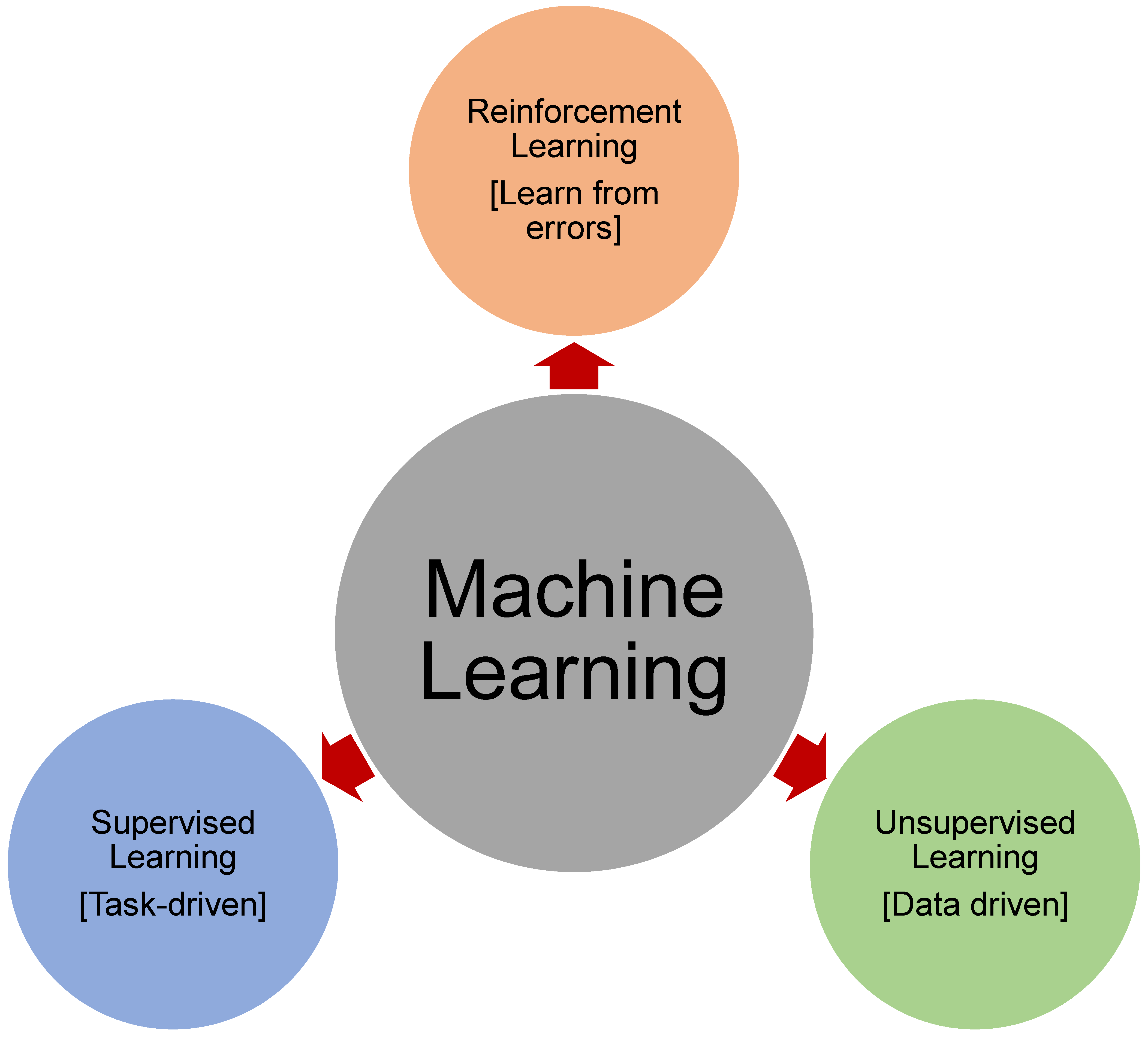

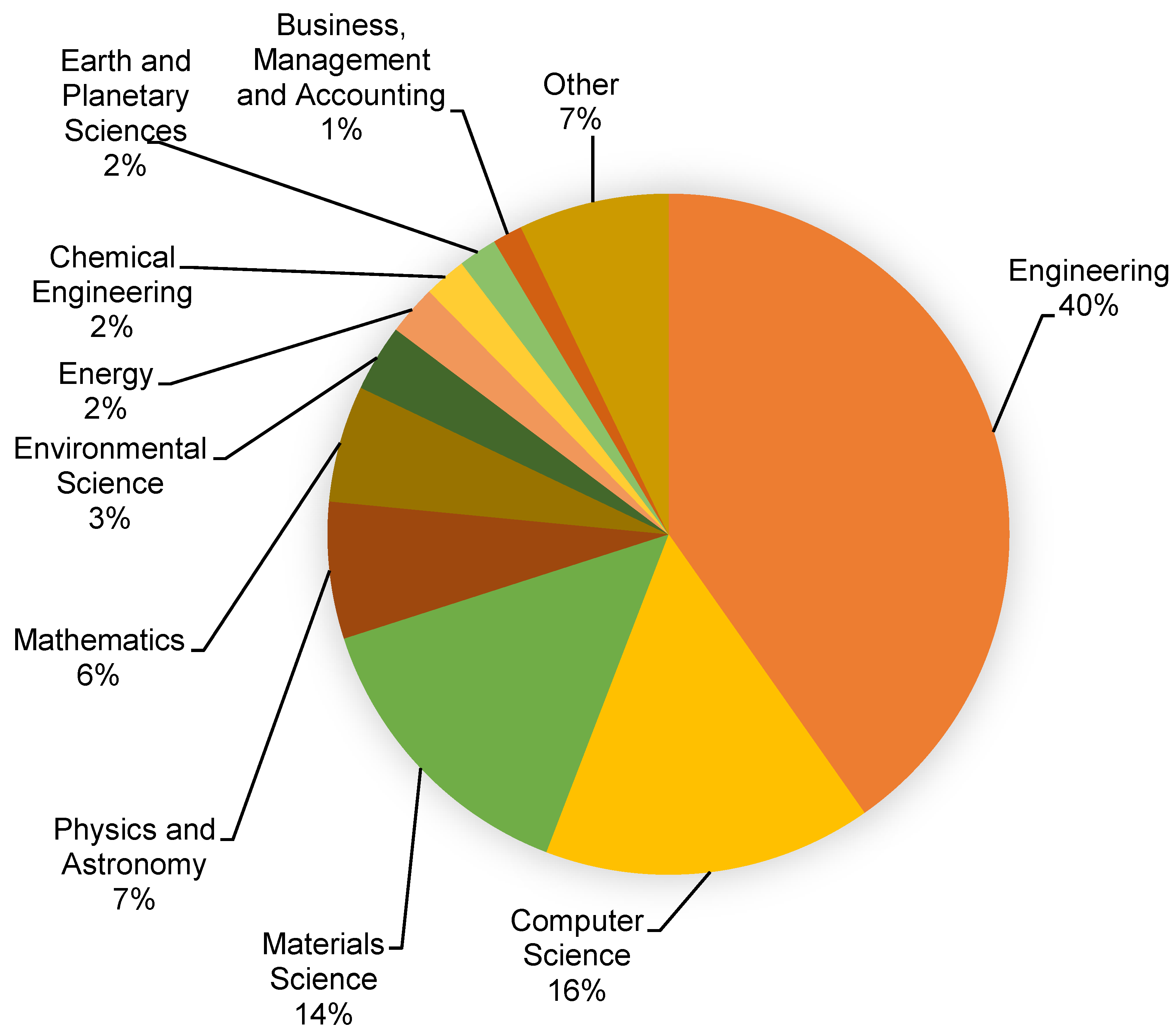
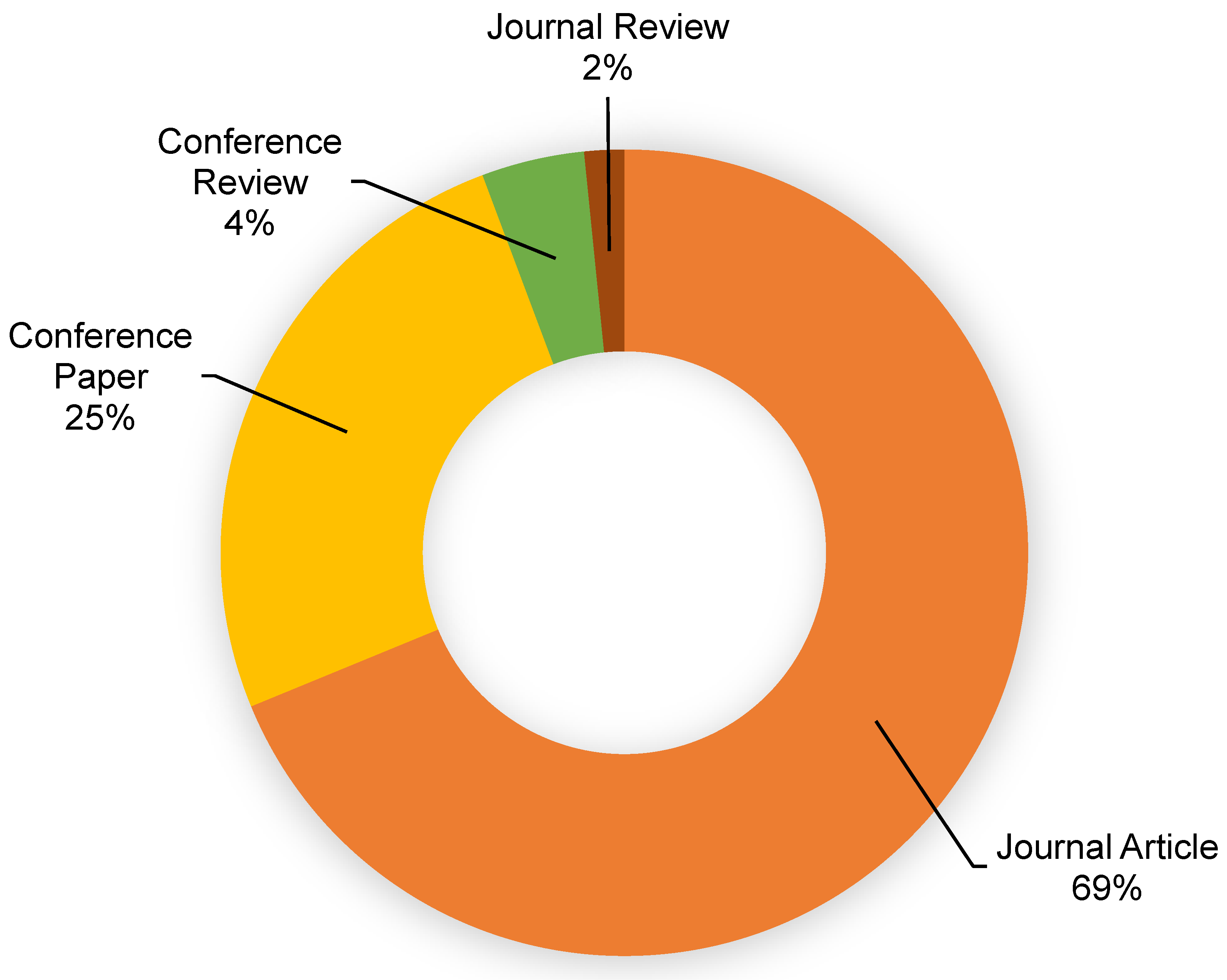
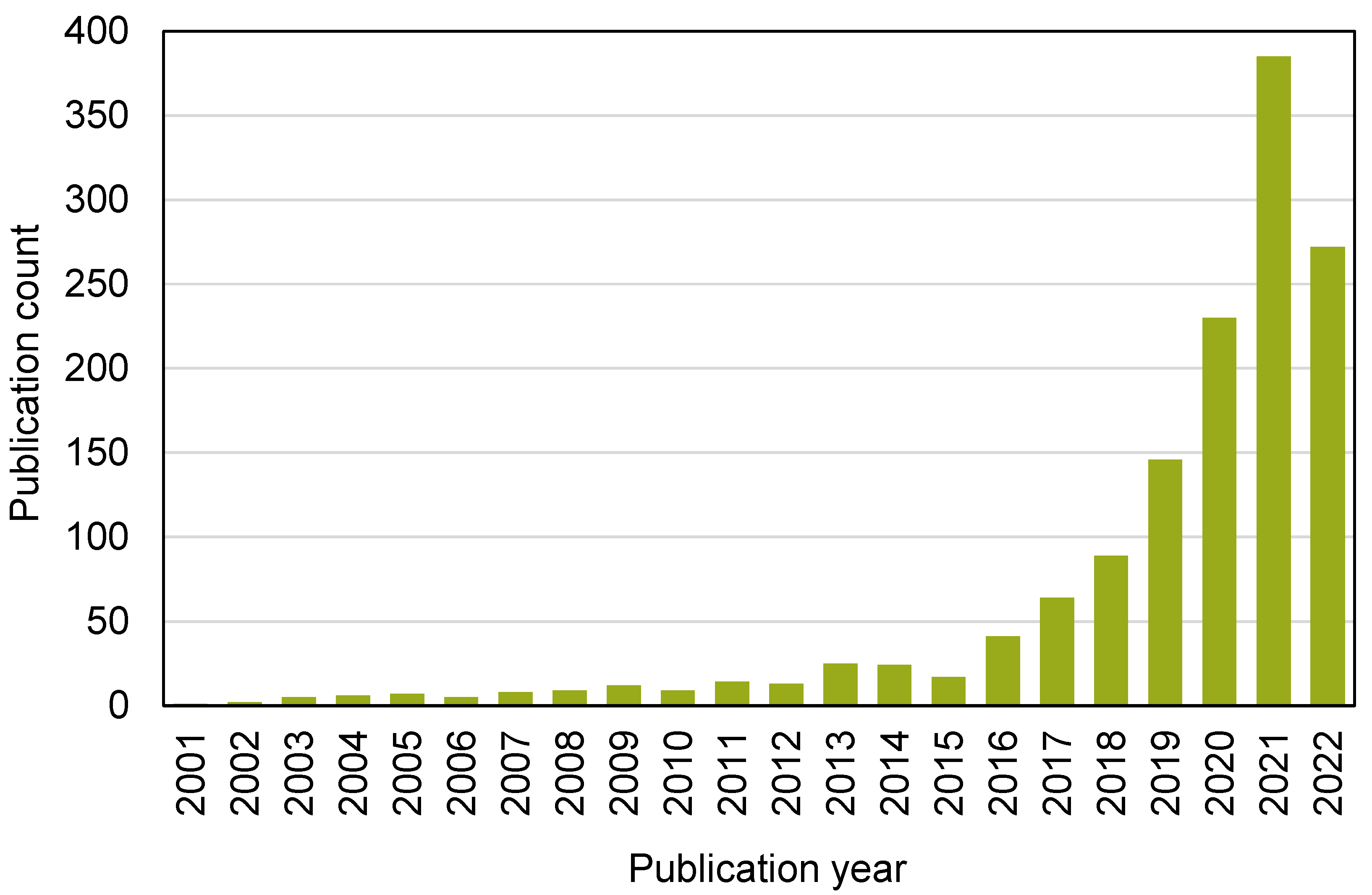
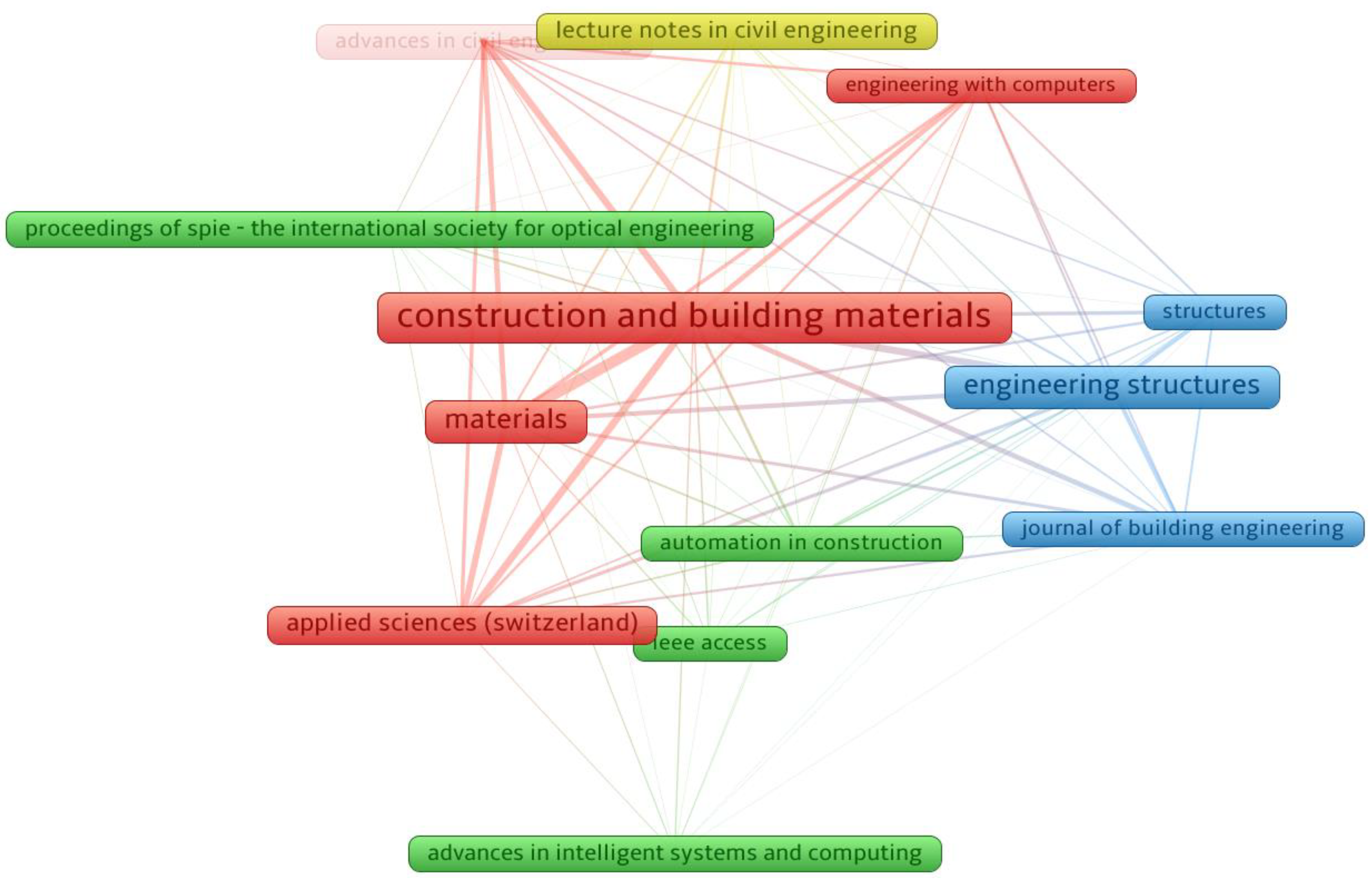
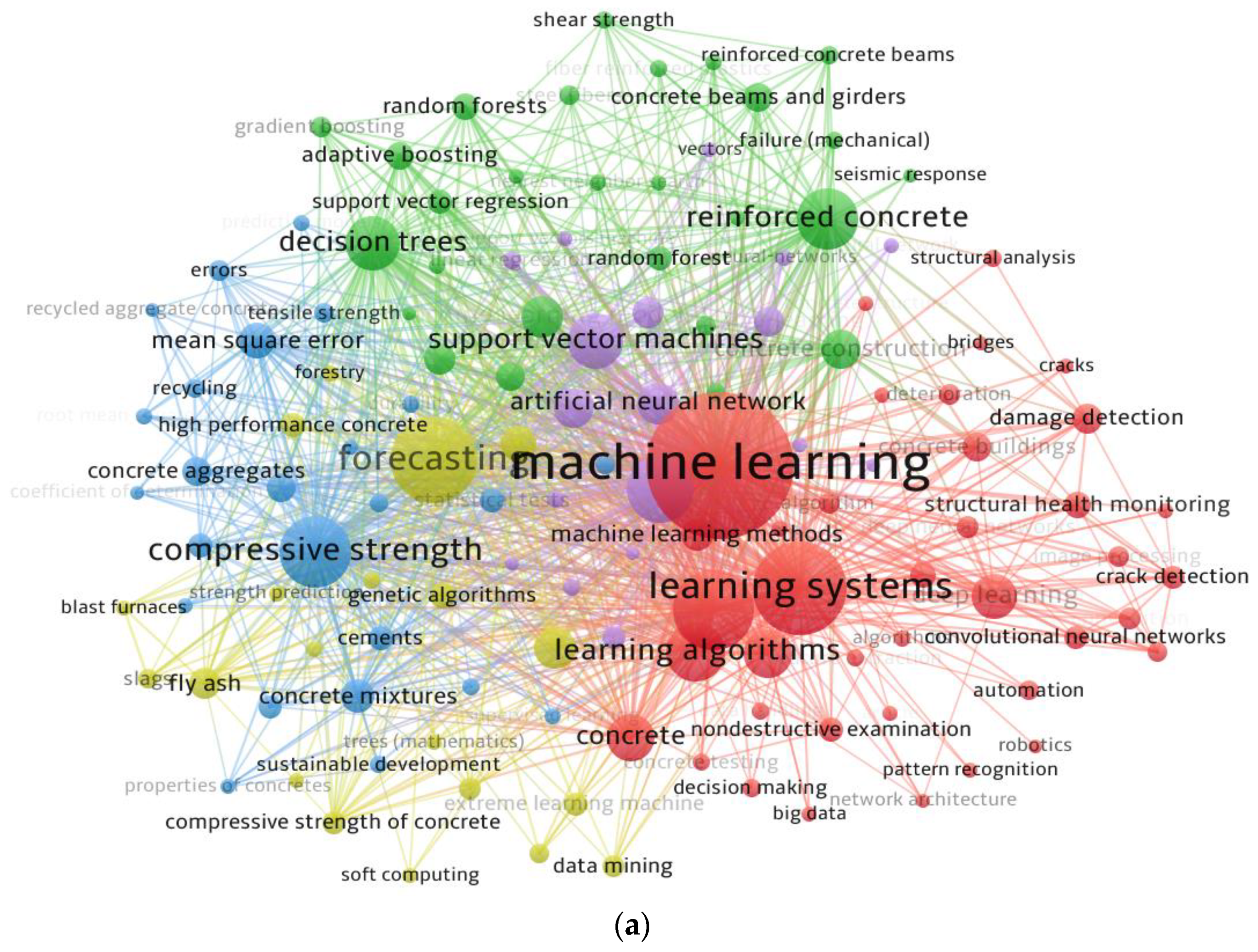

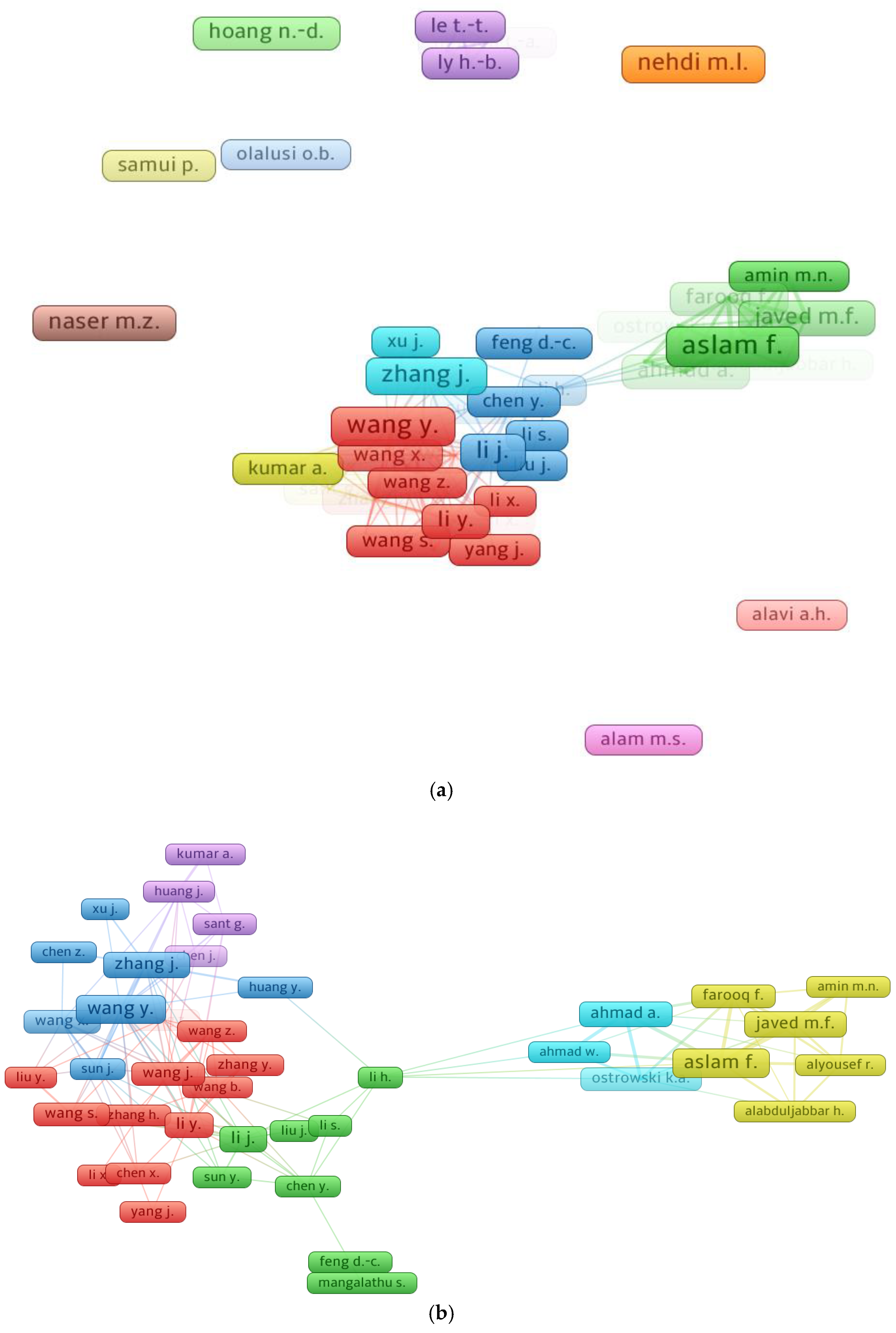
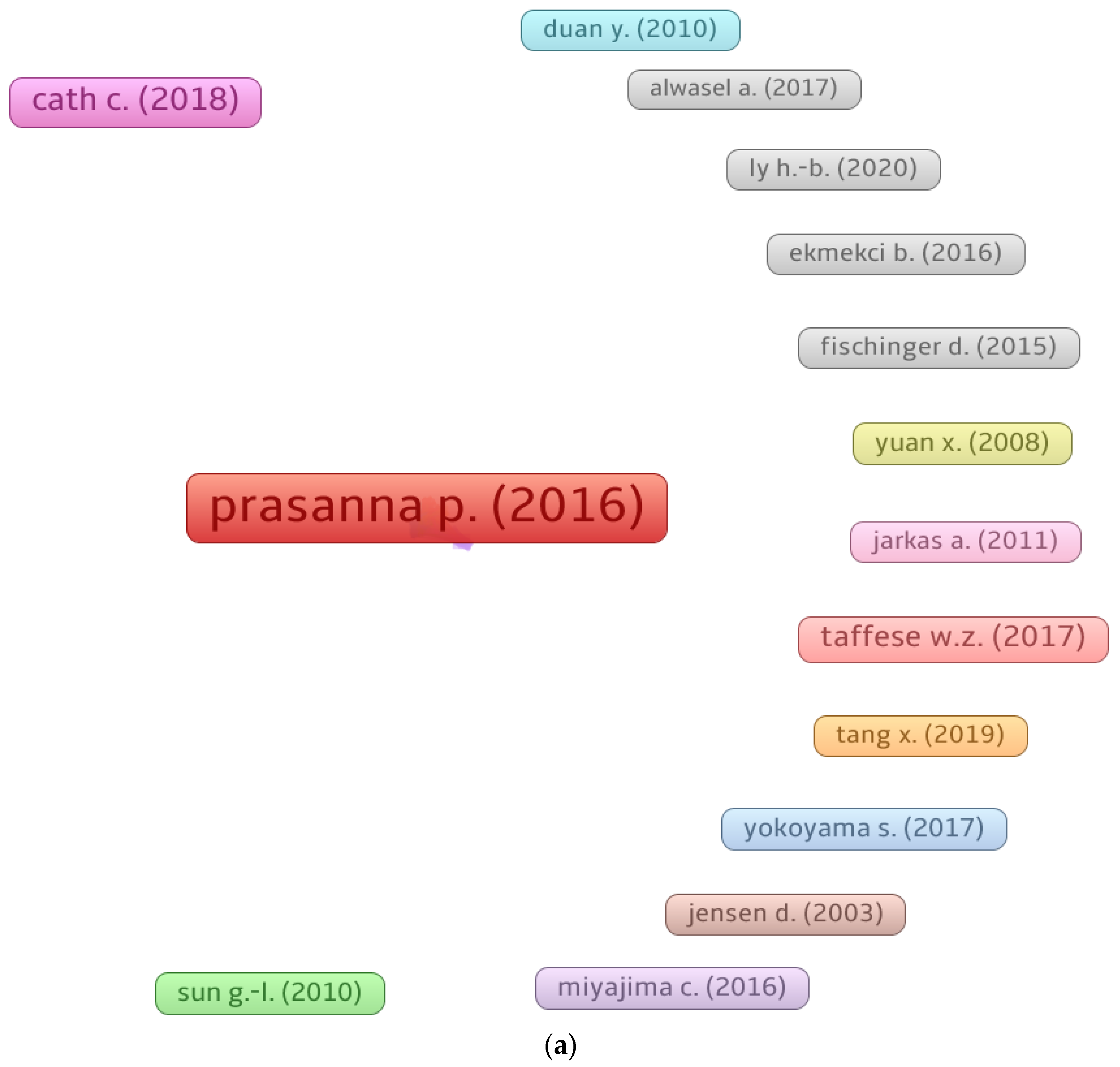
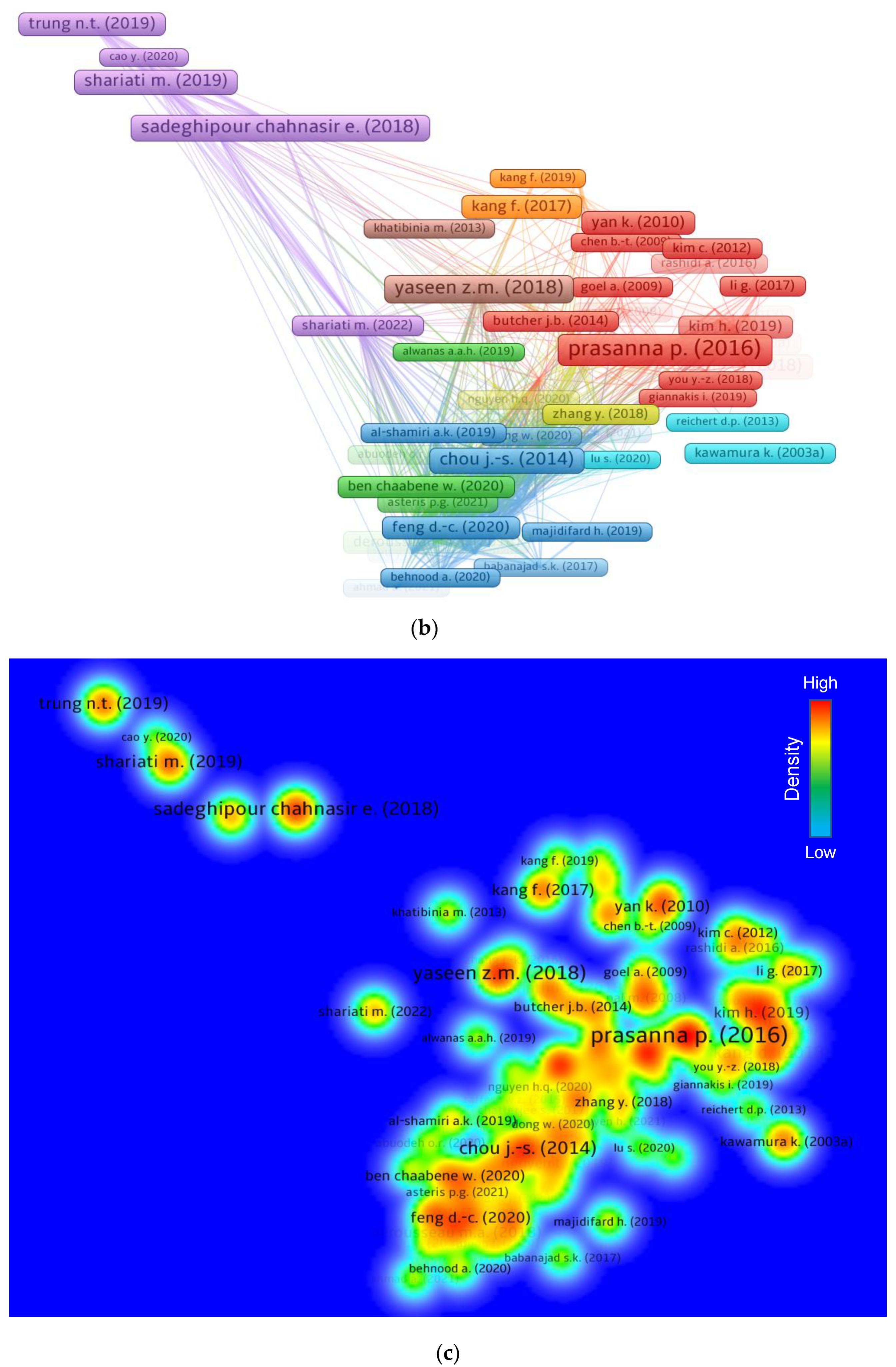
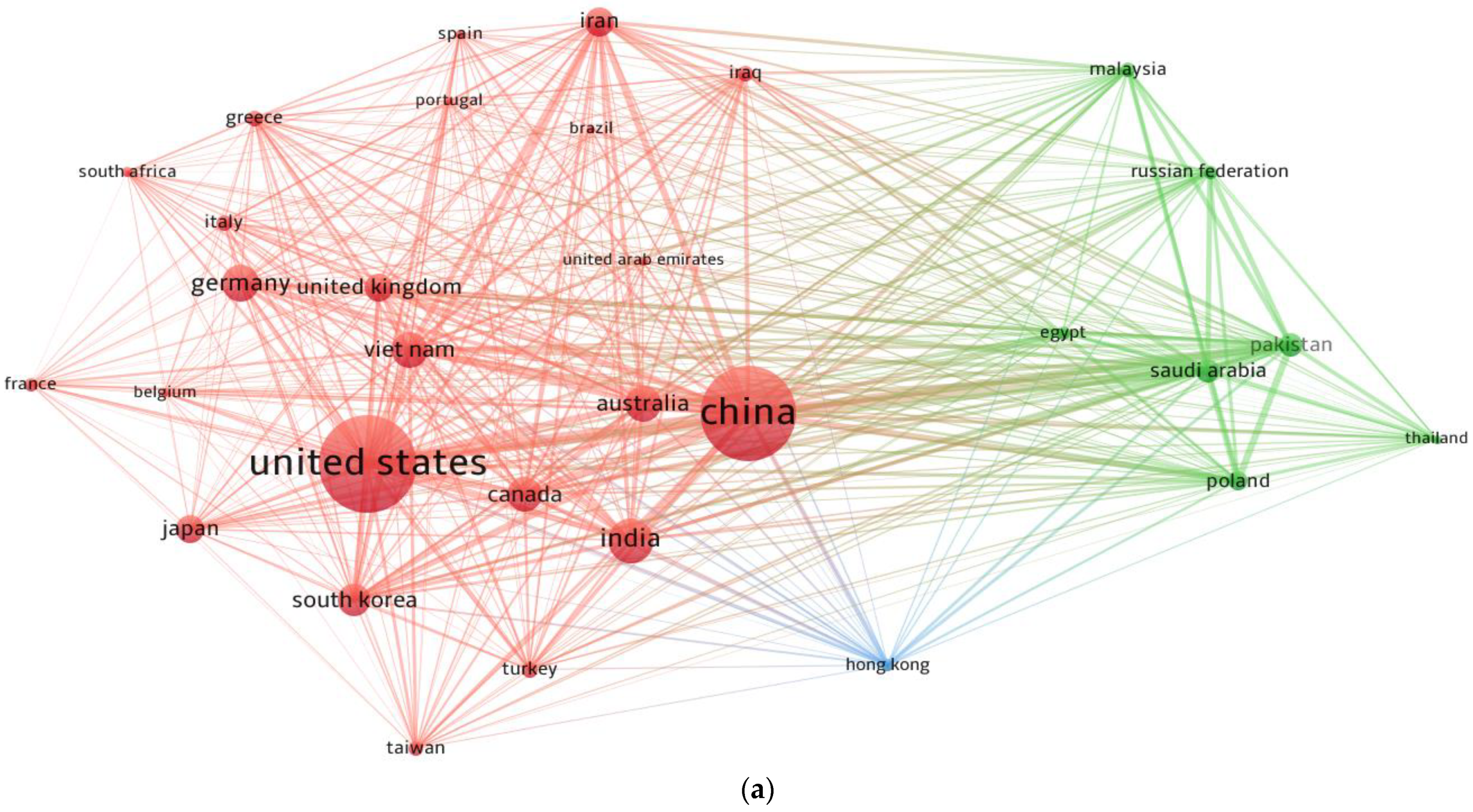

| S/N | Source Name | Total Publications | Total Citations |
|---|---|---|---|
| 1 | Construction and Building Materials | 94 | 1677 |
| 2 | Materials | 52 | 441 |
| 3 | Engineering Structures | 48 | 602 |
| 4 | Applied Sciences (Switzerland) | 35 | 258 |
| 5 | Lecture Notes in Civil Engineering | 30 | 4 |
| 6 | Proceedings of SPIE—the International Society for Optical Engineering | 23 | 32 |
| 7 | Advances in Intelligent Systems and Computing | 22 | 13 |
| 8 | Structures | 21 | 95 |
| 9 | Advances in Civil Engineering | 20 | 220 |
| 10 | Journal of Building Engineering | 18 | 185 |
| 11 | IEEE Access | 18 | 108 |
| 12 | Automation in Construction | 17 | 422 |
| 13 | Engineering with Computers | 15 | 344 |
| S/N | Keyword | Occurrences |
|---|---|---|
| 1 | Machine learning | 761 |
| 2 | Learning systems | 378 |
| 3 | Forecasting | 334 |
| 4 | Concretes | 301 |
| 5 | Compressive strength | 252 |
| 6 | Neural networks | 225 |
| 7 | Reinforced concrete | 196 |
| 8 | Learning algorithms | 185 |
| 9 | Support vector machines | 169 |
| 10 | Decision trees | 162 |
| 11 | Artificial intelligence | 137 |
| 12 | Concrete | 134 |
| 13 | Deep learning | 120 |
| 14 | Machine learning techniques | 109 |
| 15 | Artificial neural network | 108 |
| 16 | Machine learning models | 107 |
| 17 | Concrete construction | 100 |
| 18 | Regression analysis | 97 |
| 19 | Prediction | 88 |
| 20 | Mean square error | 85 |
| 21 | Concrete mixtures | 79 |
| 22 | Machine learning methods | 72 |
| 23 | Support vector machine | 71 |
| 24 | Predictive analytics | 69 |
| 25 | Fly ash | 68 |
| 26 | Damage detection | 67 |
| 27 | Machine-learning | 66 |
| 28 | Concrete buildings | 61 |
| 29 | Machine learning approaches | 61 |
| 30 | Concrete aggregates | 60 |
| S/N | Researcher Name | Total Publications | Overall Citations | Average Citations |
|---|---|---|---|---|
| 1 | Aslam F. | 25 | 297 | 12 |
| 2 | Wang Y. | 22 | 351 | 16 |
| 3 | Nehdi M.L. | 19 | 327 | 17 |
| 4 | Li J. | 18 | 295 | 16 |
| 5 | Zhang J. | 18 | 282 | 16 |
| 6 | Javed M.F. | 17 | 147 | 9 |
| 7 | Naser M.Z. | 16 | 129 | 8 |
| 8 | Ahmad A. | 15 | 159 | 11 |
| 9 | Li Y. | 15 | 66 | 4 |
| 10 | Farooq F. | 13 | 258 | 20 |
| 11 | Hoang N.-D. | 13 | 249 | 19 |
| 12 | Wang J. | 13 | 90 | 7 |
| 13 | Samui P. | 12 | 182 | 15 |
| 14 | Ostrowski K.A. | 12 | 115 | 10 |
| 15 | Wang X. | 12 | 66 | 6 |
| 16 | Wang S. | 12 | 52 | 4 |
| 17 | Le T.-T. | 11 | 222 | 20 |
| 18 | Ly H.-B. | 11 | 151 | 14 |
| 19 | Kumar A. | 10 | 141 | 14 |
| 20 | Alyousef R. | 9 | 215 | 24 |
| 21 | Feng D.-C. | 9 | 195 | 22 |
| 22 | Zhang Y. | 9 | 187 | 21 |
| 23 | Yang J. | 9 | 40 | 4 |
| 24 | Mangalathu S. | 8 | 385 | 48 |
| 25 | Chen Y. | 8 | 136 | 17 |
| 26 | Alavi A.H. | 8 | 118 | 15 |
| 27 | Tran V.Q. | 8 | 106 | 13 |
| 28 | Zhang Z. | 8 | 64 | 8 |
| 29 | Chen X. | 8 | 51 | 6 |
| 30 | Ahmad W. | 8 | 46 | 6 |
| 31 | Wang Z. | 8 | 32 | 4 |
| 32 | Liu J. | 7 | 157 | 22 |
| 33 | Li S. | 7 | 152 | 22 |
| 34 | Chen Z. | 7 | 146 | 21 |
| 35 | Huang J. | 7 | 133 | 19 |
| 36 | Sant G. | 7 | 127 | 18 |
| 37 | Amin M.N. | 7 | 117 | 17 |
| 38 | Huang Y. | 7 | 108 | 15 |
| 39 | Xu J. | 7 | 103 | 15 |
| 40 | Thai H.-T. | 7 | 97 | 14 |
| 41 | Alabduljabbar H. | 7 | 86 | 12 |
| 42 | Chen J. | 7 | 85 | 12 |
| 43 | Sun Y. | 7 | 79 | 11 |
| 44 | Nguyen T.-A. | 7 | 71 | 10 |
| 45 | Sun J. | 7 | 61 | 9 |
| 46 | Olalusi O.B. | 7 | 43 | 6 |
| 47 | Zhang H. | 7 | 43 | 6 |
| 48 | Marani A. | 7 | 37 | 5 |
| 49 | Li X. | 7 | 34 | 5 |
| 50 | Wang B. | 7 | 29 | 4 |
| 51 | Alam M.S. | 7 | 14 | 2 |
| 52 | Liu Y. | 7 | 14 | 2 |
| 53 | Li H. | 7 | 10 | 1 |
| S/N | Article | Title | Total Number of Citations Received |
|---|---|---|---|
| 1 | Prasanna P. [98] | Automated Crack Detection on Concrete Bridges | 224 |
| 2 | Rafiei M.H. [99] | A novel machine learning-based algorithm to detect damage in high-rise building structures | 184 |
| 3 | Chou J.-S. [100] | Optimizing the prediction accuracy of concrete compressive strength based on a comparison of data-mining techniques | 174 |
| 4 | Yaseen Z.M. [101] | Predicting compressive strength of lightweight foamed concrete using extreme learning machine model | 170 |
| 5 | Sadeghipour Chahnasir E. [102] | Application of support vector machine with firefly algorithm for investigation of the factors affecting the shear strength of angle shear connectors | 165 |
| S/N | Country | Documents Published | Overall Citations |
|---|---|---|---|
| 1 | United States | 298 | 4260 |
| 2 | China | 289 | 2732 |
| 3 | India | 110 | 725 |
| 4 | Germany | 84 | 479 |
| 5 | Vietnam | 82 | 1633 |
| 6 | Australia | 81 | 1066 |
| 7 | Canada | 77 | 824 |
| 8 | South Korea | 72 | 1063 |
| 9 | Iran | 62 | 1188 |
| 10 | United Kingdom | 58 | 578 |
| 11 | Japan | 58 | 468 |
| 12 | Saudi Arabia | 48 | 477 |
| 13 | Pakistan | 47 | 404 |
| 14 | Poland | 35 | 373 |
| 15 | Italy | 29 | 236 |
| 16 | Turkey | 29 | 217 |
| 17 | Iraq | 27 | 610 |
| 18 | Greece | 27 | 170 |
| 19 | Malaysia | 26 | 658 |
| 20 | Taiwan | 25 | 638 |
| 21 | Russian Federation | 24 | 59 |
| 22 | France | 22 | 237 |
| 23 | Egypt | 22 | 148 |
| 24 | Hong Kong | 21 | 175 |
| 25 | South Africa | 16 | 68 |
| 26 | Spain | 15 | 280 |
| 27 | United Arab Emirates | 14 | 99 |
| 28 | Thailand | 13 | 68 |
| 29 | Belgium | 12 | 170 |
| 30 | Portugal | 12 | 117 |
| 31 | Brazil | 10 | 18 |
| Ref. | Material Type | Properties Predicted | ML Techniques Employed | No. of Input Parameters | Data Points | Best ML Technique Recommended |
|---|---|---|---|---|---|---|
| [49] | Recycled aggregate concrete | Compressive strength | Decision tree, gradient boosting, and bagging regressor | 8 | 638 | Bagging regressor |
| [106] | Concrete-filled steel tubes | Ultimate axial capacity | GEP | 6 | 227 | - |
| [107] | Geopolymer concrete | Compressive strength | Decision tree, GEP, bagging regressor, and random forest | 9 | 371 | Bagging regressor |
| [105] | High-performance concrete | Compressive strength | Decision tree, multilayer perceptron neural network, support vector machine, extreme gradient boosting, AdaBoost, bagging regressor, and random forest | 8 | 1030 | Random forest and decision tree with bagging |
| [53] | Recycled aggregate concrete | Splitting tensile strength | GEP, ANN, and bagging regressor | 9 | 166 | Bagging regressor |
| [103] | Rice husk ash concrete | Compressive strength | GEP and random forest | 6 | 192 | GEP |
| [52] | Recycled aggregate concrete | Compressive and flexural strength | Gradient boosting and random forest | 12 | 638 | Random forest |
| [108] | Geopolymer concrete | Compressive strength | Decision tree, random forest, and AdaBoost | 9 | 363 | AdaBoost and random forest |
| [109] | Recycled aggregate concrete | Compressive and splitting tensile strength | AdaBoost and decision tree | 9 | 344 | AdaBoost |
| [110] | Geopolymer concrete | Compressive strength | Decision tree, bagging regressor, and AdaBoost | 9 | 154 | Bagging regressor |
| [51] | High-performance concrete | Compressive strength | Support vector machine, AdaBoost, and random forest | 7 | 1030 | Random forest |
| [35] | High-performance concrete | Compressive strength | Decision tree, GEP, AdaBoost, and bagging regressor | 8 | 1030 | Bagging regressor |
| [8] | Recycled aggregate concrete | Compressive strength | GEP and ANN | 9 | 344 | GEP |
| [111] | Fly-ash-based concrete | Compressive strength | GEP, ANN, decision tree, and bagging regressor | 7 | 98 | Bagging regressor |
| [104] | Fly-ash-based concrete | Compressive strength | GEP, decision tree, and bagging regressor | 8 | 270 | Bagging regressor |
| [112] | Waste-material-based concrete | Surface chloride concentration | GEP, decision tree, and ANN | 12 | 642 | GEP |
| [113] | High-strength concrete | Compressive strength | GEP and random forest | 5 | 357 | Random forest |
Publisher’s Note: MDPI stays neutral with regard to jurisdictional claims in published maps and institutional affiliations. |
© 2022 by the authors. Licensee MDPI, Basel, Switzerland. This article is an open access article distributed under the terms and conditions of the Creative Commons Attribution (CC BY) license (https://creativecommons.org/licenses/by/4.0/).
Share and Cite
Khan, K.; Ahmad, W.; Amin, M.N.; Ahmad, A. A Systematic Review of the Research Development on the Application of Machine Learning for Concrete. Materials 2022, 15, 4512. https://doi.org/10.3390/ma15134512
Khan K, Ahmad W, Amin MN, Ahmad A. A Systematic Review of the Research Development on the Application of Machine Learning for Concrete. Materials. 2022; 15(13):4512. https://doi.org/10.3390/ma15134512
Chicago/Turabian StyleKhan, Kaffayatullah, Waqas Ahmad, Muhammad Nasir Amin, and Ayaz Ahmad. 2022. "A Systematic Review of the Research Development on the Application of Machine Learning for Concrete" Materials 15, no. 13: 4512. https://doi.org/10.3390/ma15134512
APA StyleKhan, K., Ahmad, W., Amin, M. N., & Ahmad, A. (2022). A Systematic Review of the Research Development on the Application of Machine Learning for Concrete. Materials, 15(13), 4512. https://doi.org/10.3390/ma15134512






